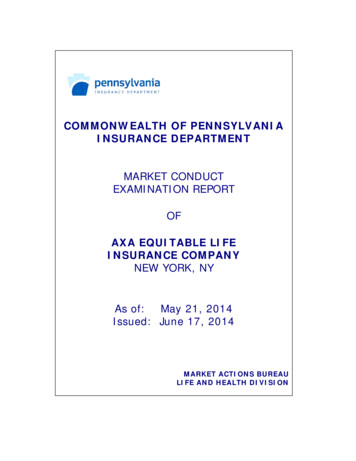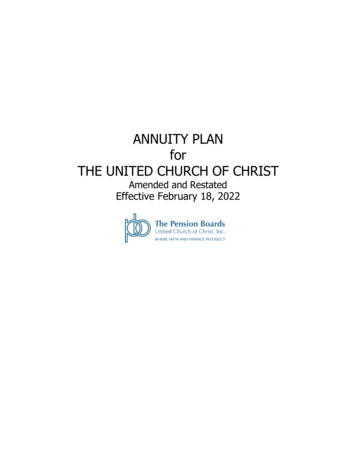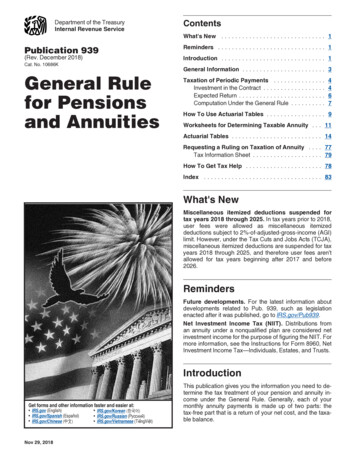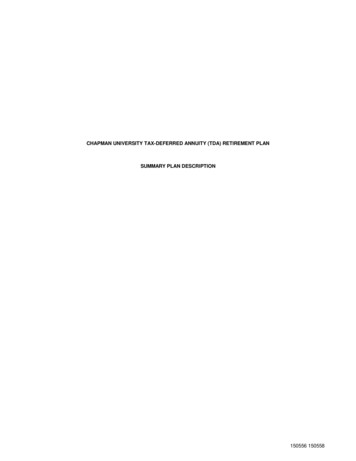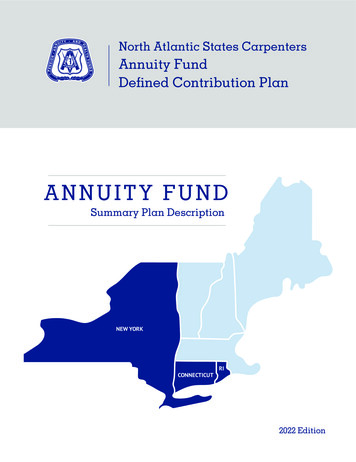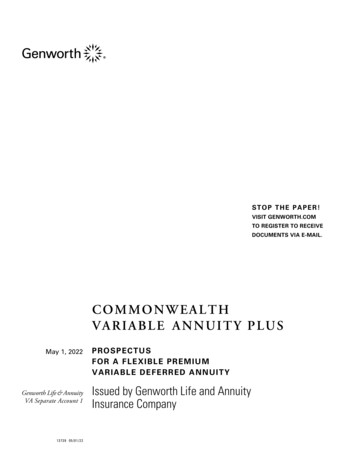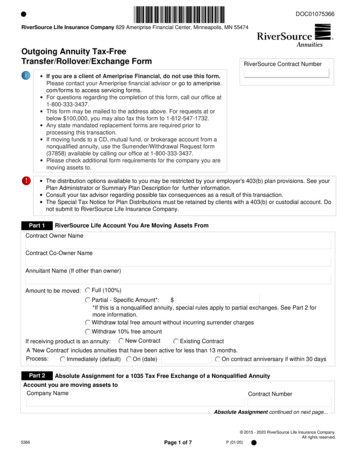
Transcription
DOC01075366RiverSource Life Insurance Company 829 Ameriprise Financial Center, Minneapolis, MN 55474Outgoing Annuity Tax-FreeTransfer/Rollover/Exchange FormRiverSource Contract Numberi If you are a client of Ameriprise Financial, do not use this form.Please contact your Ameriprise financial advisor or go to ameriprise.com/forms to access servicing forms. For questions regarding the completion of this form, call our office at1-800-333-3437. This form may be mailed to the address above. For requests at orbelow 100,000, you may also fax this form to 1-612-547-1732. Any state mandated replacement forms are required prior toprocessing this transaction. If moving funds to a CD, mutual fund, or brokerage account from anonqualified annuity, use the Surrender/Withdrawal Request form(37858) available by calling our office at 1-800-333-3437. Please check additional form requirements for the company you aremoving assets to.! The distribution options available to you may be restricted by your employer's 403(b) plan provisions. See yourPlan Administrator or Summary Plan Description for further information. Consult your tax advisor regarding possible tax consequences as a result of this transaction. The Special Tax Notice for Plan Distributions must be retained by clients with a 403(b) or custodial account. Donot submit to RiverSource Life Insurance Company.Part 1RiverSource Life Account You Are Moving Assets FromContract Owner NameContract Co-Owner NameAnnuitant Name (If other than owner)Amount to be moved:Full (100%)Partial - Specific Amount*: *If this is a nonqualified annuity, special rules apply to partial exchanges. See Part 2 formore information.Withdraw total free amount without incurring surrender chargesWithdraw 10% free amountIf receiving product is an annuity:New ContractExisting ContractA 'New Contract' includes annuities that have been active for less than 13 months.Process:Immediately (default)On (date)On contract anniversary if within 30 daysPart 2Absolute Assignment for a 1035 Tax Free Exchange of a Nonqualified AnnuityAccount you are moving assets toCompany NameContract NumberAbsolute Assignment continued on next page.5366Page 1 of 7 2015 - 2020 RiverSource Life Insurance Company.All rights reserved.P (01/20)
DOC02075366Absolute Assignment continuedContract Owner NameContract Co-Owner NameAnnuitant NameAdvisor/Agent Name (If applicable)Product NameProduct Type (Select one):Fixed AnnuityFixed Index AnnuityOtherVariable AnnuityImmediate AnnuityMarket Value AnnuityStructured AnnuityLong-Term Care The purpose of this assignment is to effect a nontaxable exchange of part or all of this contract under InternalRevenue Code Section 1035, Revenue Ruling 2002-75, Revenue Ruling 2003-76 and Revenue Procedure 2011-38. I hereby assign the portion of my rights, title, and interest in the policy number identified above to the companynamed in Part 2 (company exchanging to). The purpose of this assignment is to effect a non-taxable exchange ofthis contract under Internal Revenue Code Section 1035(a) and the regulations and rulings issued under thatsection. Do not withhold federal income taxes. If this is an annuity to annuity partial exchange, the investment of the original contract will be allocatedproportionately between the original and new contracts. IRS Revenue Procedure 2011-38 states if withdrawals aretaken from either annuity within a 180-day period following a partial 1035 exchange, the IRS will apply general taxprinciples to determine the tax treatment of the previous exchange and the subsequent withdrawal. For example, adistribution from either contract within 180 days of the exchange may result in additional taxable income related tothe contracts involved in the exchange. The IRS tax treatment may be different than what is reported on Form1099-R. A tax advisor should be contacted before any withdrawals are taken from either annuity contract during the180-day period. This 180-day limitation on withdrawals does not to apply to annuitized amounts if the annuitizationis for life/lives or a period of 10 years or more. Partial 1035 Exchanges to Qualified Long-Term Care Insurance Policies: The IRS has not yet provided rulesregarding 1035 exchanges into qualified long-term care insurance products. There may be unintended taxconsequences once the IRS provides guidance on these exchanges. The investment of the annuity contract will beadjusted proportionately based on the portion of the contract value exchanged, unless the IRS provides otherwise.Please consult your tax advisor.Part 3Trustee to Trustee Transfer or Direct Rollover of a Qualified AnnuityAccount you are moving assets toCompany NameContract Owner NameContract NumberProduct NameProduct Type (Select one):Fixed AnnuityFixed Index AnnuityOtherVariable AnnuityImmediate AnnuityMarket Value AnnuityStructured AnnuityLong-Term CarePlan Type (Select one):Roth IRASEP IRASIMPLE IRATraditional IRAInherited (Beneficial) RothInherited (Beneficial) SEP IRAInherited (Beneficial) Traditional IRATax Sheltered Custodial Account (TSCA)401(a)457Tax Sheltered Annuity (TSA)OtherTrustee to Trustee Transfer or Direct Rollover continued on next page.5366Page 2 of 7P (01/20)
DOC03075366Trustee to Trustee Transfer or Direct Rollover continuedTSA Contracts Only This transaction is intended to qualify as tax-free Contract Exchange or Plan to Plan Transfer. A contractexchange occurs when an employee changes from one 403(b) investment option allowed under the plan toanother investment option in the same plan. No tax reporting is required on a Contract Exchange. A Plan to Plan Transfer occurs when an employee moves all or a portion of their 403(b) account from oneemployer’s plan into an investment product offered by a different employer’s 403(b) plan. No tax reporting isrequired on a Plan to Plan Transfer.TSA Contracts - Direct Rollover OnlyI have read the “Special Tax Notice for Plan Distributions” and I understand that I have the right to consider thedecision of whether or not to consent to a distribution and/or to elect a direct rollover for at least 30 days. I furtherunderstand that if I submit a completed distribution form before this 30 day period expires, I will have waived theserights and processing of my distribution request will begin upon receipt.I met the following triggering events (check all that apply):I have attained age 59½ by the date of this request.I am the surviving spouse beneficiary of the deceased annuitant.I am a surviving non-spouse beneficiary of the deceased annuitant and the plan allows rolling to an Inherited IRA.I have severed employment (including retirement) with the employer this contract is associated with.Severance DateWere/will you be age 55 in the calendar year you severed employment?YesNoI certify I am aware of the rules and requirements regarding 403(b) account transfers and exchanges and have hadthe opportunity to consult with my personal tax adviser regarding this transaction.Part 4iPlan Sponsor Information (TSA/403(b) plans only)Please complete the Plan Sponsor section below. If you are currently retired, unemployed, or working for anemployer who does not sponsor a 403(b) program, your 403(b) account is deemed associated with your mostrecent employer who sponsored the 403(b) arrangement.Employer Identification Number(EIN) (Required)Name of Plan Sponsor (Required)Phone NumberContact Name and TitleMailing Address (Required)CityPart 5StateZIP codeWithholding InstructionsDirect Conversion from TSA to a Roth IRAA direct conversion from a TSA to a Roth IRA results in income tax being due on the taxable portion of the transaction.Please see the Special Tax Notice for Plan Distributions. You should consult with a tax advisor prior to requesting thistransaction. There will be no withholding on this request unless you elect withholding below.Direct Conversion from a Traditional, SEP or SIMPLE IRA to a Roth IRA If taxes are withheld from this distribution, the net conversion amount will be the gross amount requested - (minus)the tax withholding. If your annuity contract is subject to contractual surrender charges and you elect withholding, surrender charges willapply to the amount withheld. Federal Withholding: You are liable for federal income tax on the taxable portion of your distribution. If totalwithholding is not adequate, you may be subject to estimated tax payments and/or penalties.Withholding Instructions continued on next page.5366Page 3 of 7P (01/20)
DOC04075366Withholding Instructions continued State Withholding: Withholding rules vary by state. Clients may have the option to: (1) opt-out withholding, (2) electdefault state taxwithholding, or (3) increase the rate of withholding. Depending on the state, state tax withholdingcould be mandatory, optional, unavailable, or the client may need to complete a state-specific form. For state taxwithholding rules, go to riversource.com/statetax. Please note that taxes withheld per your elections or in accordance with state rules will not be refunded. Different withholding rules apply in certain situations: If we do not have a valid Taxpayer Identification Number onthe account, if the payment is delivered outside the United States or if you are a non-resident. Please consult your tax professional for additional information regarding federal and/or state withholding.Federal Withholding 10% federal tax will be withheld unless you make a different withholding election below. If you are under 59 ½ and your withdrawal includes taxable income, an IRS early withdrawal penalty may apply.Do not withhold federal taxWithhold 10% federal tax% federal tax- must be more than 10%WithholdState Withholding If you do not indicate an election, we will generally follow your choice for federal election unless your statedoes not allow. No state tax withholding will be taken for states where withholding is not available. The taxpayer's resident state on file is the state we use for state tax withholding.Do not withhold state default taxPart 6Withhold default state taxWithhold% state taxAcknowledgments and SignaturesBy signing this form, I also acknowledge and accept the following conditions: I am the owner of the listed RiverSource Life Insurance Company (RiverSource Life) contract and I authorizeRiverSource Life to process this transaction. The appropriate state replacement forms have been sent and are attached to this form, if applicable. I hold RiverSource Life harmless from any income or excise tax liability, including penalties and interest, as a resultof this transaction. I have taken the Required Minimum Distribution (RMD), if any, pursuant to Internal Revenue Code Section 401(a)(9)and related federal tax rules. I have received a letter from RiverSource Life explaining, and I understand my right to receive information regardingthe existing policy or contract values, including, if available, a policy summary. Please verify the withdrawal provisions and conditions of your contract prior to making a selection. Make sure you understand the impact taking this withdrawal will have on your contract values. Certain riders containfeatures that may be negatively impacted by taking a withdrawal. For contracts with a guaranteed withdrawal benefit, if the partial surrenders/withdrawals in any contract year exceedthe permitted surrender/withdrawal amount under the terms of the rider, benefits under the rider may be reduced.Accounts/Funds Expenses of the underlying funds may be different. Past performance history used in sales literature does not necessarily reflect future performance. For fixed index annuities: Any money withdrawn from a segment before its maturity date will not receive interest.Acknowledgements and Signatures continued on next page.5366Page 4 of 7P (01/20)
DOC05075366Acknowledgments and Signatures continuedCharges/Expenses Surrender charges may be imposed on the account value of my annuity contract prior to this transaction and that itmay not be in my best interest to begin a new surrender charge schedule. A market value adjustment may apply to the amount withdrawn from my annuity contract. Ongoing mortality expense, administrative and annual contract charges under a new contract may differ. Fees for the contract features such as guarantees, death benefits and partial withdrawal may differ.Annuity Contracts With a Guaranteed Withdrawal Benefit Rider (Partial Withdrawals Only) If your annuity has a withdrawal benefit rider with the Base Doubler feature, any withdrawal taken (includingRMDs) before the Base Doubler effective date will permanently set the Base Doubler value to 0. If you have a variable annuity with the SecureSource rider, SecureSource Flex rider, SecureSource Stages rider, SecureSource Stages 2 rider, and are invested in the Portfolio Navigator Aggressive or ModeratelyAggressive fund, taking this withdrawal will move the contract into the Moderate fund. Once you take a withdrawalyou may invest in the Portfolio Navigator Conservative, Moderately Conservative, or Moderate fund withoutaffecting your guaranteed benefit values. If you take this withdrawal and later choose to move to one of the moreaggressive Portfolio Navigator funds, your guaranteed benefit values will be reset based on the lesser of yourcontract values or your guarantees at that time. You also have the option to transfer to any Portfolio Stabilizerfund. You can invest in any Portfolio Stabilizer fund while taking withdrawals without impacting your guaranteedbenefit values. It’s important to note that if you transfer to one or more Portfolio Stabilizer fund(s), you willnot be able to transfer back to any of the Portfolio Navigator funds. If you have an annuity with a guaranteed withdrawal benefit rider and you take a withdrawal that is higherthan the maximum guaranteed amount, it is considered an "excess withdrawal." An excess withdrawalcould permanently decrease your guaranteed income and benefit values. If you would like to make awithdrawal and are uncertain of whether it would be considered an excess withdrawal or would like to see how anexcess withdrawal will impact your future guaranteed income and benefit values, please call a Client ServiceRepresentative at 1-800-333-3437 to request a personalized calculation showing the effect of the withdrawal priorto submitting this request. If you do not contact us prior to submitting this form and the amount you haverequested will result in an excess withdrawal, we will require that you complete the "Benefit ImpactAcknowledgement Form" before processing can occur.Owner SignatureDate (MMDDYYYY)XOwner Phone NumberJoint Owner SignatureDate (MMDDYYYY)XConsent of spouse is required for distributions from 403(b) plans that are subject to ERISA. If you are unsure if your plan issubject to ERISA (and consequently spousal consent requirements) check with your plan sponsor. (Usually your employer).Generally: 403(b) plans sponsored by a governmental entity such as a public school or university are not subject to ERISA. 403(b) plans sponsored by a church or qualified church controlled organization are generally not subject to ERISA,however some exceptions may apply. 403(b) plans sponsored by a 501(c)(3) (non-profit) organization may be subject to ERISA depending on the design andoperation of the plan.Acknowledgements and Signatures continued on next page.5366Page 5 of 7P (01/20)
DOC06075366Acknowledgments and Signatures continuedSpousal Consent!The spouse's signature must be witnessed by either the Plan Sponsor/Administrator or a Notary Public.Owner's marital status:SingleMarriedWidowedDivorcedI understand that, as the owner’s spouse, I have certain rights concerning his or her benefits, including the right toreceive any death benefits unless I consent to another disposition. I hereby consent to the above requestedwithdrawal and I acknowledge that this consent will have the effect of waiving any and all rights concerning thiswithdrawal.Spouse NameSpouse SignatureDate (MMDDYYYY)XNotarizationState of :County of :On, 20Month, Date,personally appeared before me,Name of SpouseYrwho is personally known to mewhose identity I proved on the basis ofwhose identity I proved on the oath/affirmation ofa credible witness,To be the signer of the above document, and he/she acknowledged that he/she signed it.Signature of NotaryDate (MMDDYYYY)XThis notarization must include the Notary's official seal to be accepted as complete. The seal must be affixed byinked stamp imprint (preferred), or photocopiable emboss. Electronic notarizations cannot be accepted.Notary Seal:Plan Sponsor/Third Party Administrator Acknowledgements and SignatureFor governmental and ERISA plans, the requested transaction has been approved and meets applicable legalrequirements; OR for 501(c)(3) non-ERISA plans, the Plan Sponsor or Third Party Administrator represents that theparticipant had a termination of employment if Part 2 indicates that the distribution is based on severance ofemployment.For ERISA Plans, with the authority to act on behalf of the Plan, I certify that the marital status selected is correct and ifthe participant is married and the Notary section has not been completed, the participant's spouse(name of spouse)personally appeared before me with evidence to be the person whose name is named above and executed theforegoing document voluntarily.Acknowledgements and Signatures continued on next page.5366Page 6 of 7P (01/20)
DOC07075366Acknowledgments and Signatures continuedPlan Sponsor/Third Party Administrator Authorized Signer NamePlan Sponsor/Third Party Administrator SignatureDate (MMDDYYYY)XPlan Sponsor/Designated Plan Administrator Notes Section –Amount approved if different than requested Part 7Letter of Acceptance and Surrender Request (Completed by a Corporate Officer of Companyreferenced in Part 2 or Part 3)Please note cost basis information will be sent along with the check.Tax-Qualified Contracts:By signature of an authorized officer below, the company named in Part 3 accepts assignment of the above-referencedpolicy for the purpose of complying with the client’s intention of effecting either a rollover of tax-qualified funds or adirect transfer of the tax-qualified funds. In the case of a 403(b) Exchange or Transfer, the Company named in Part 3further acknowledges that they are an approved investment provider for the 403(b) plan sponsored by the Employeridentified in Part 3 or are a de-selected investment provider eligible to receive exchanges or transfers.Nonqualified Annuity Contracts:By signature of an authorized officer below, the company named in Part 2 accepts assignment of the portion of theabove identified contract for the purpose of complying with the client’s intention of effecting a non-taxable exchangeunder IRC section 1035. Acceptance by RiverSource Life of this assignment and of contract values from otherinsurance companies should not be construed as a guarantee that the transaction will qualify as a 1035 exchange.Corporate Officer Signature and TitleDate (MM/DD/YYYY)XDelivery Instructions:Make Check Payable toMail Check toMailing AddressCityStateZIP codeTHIS FORM IS VOID IF NOT SUBMITTED WITHIN 60 DAYS OF SIGNING5366Page 7 of 7P (01/20)
This page is intentionally left blank5366P (01/20)
SPECIAL TAX NOTICE FOR PLAN DISTRIBUTIONSFor Payments Not From a Designated Roth AccountYOUR ROLLOVER OPTIONSYou are receiving this notice because all or a portion of a payment you are receiving from the 403(b) annuity or custodial account relating to youremployer’s plan (the “Plan”) is eligible to be rolled over to an IRA or an employer plan. This notice is intended to help you decide whether to do such arollover.This notice describes the rollover rules that apply to payments from the Plan that are not from a designated Roth account (a type of account with specialtax rules in some employer plans). If you also receive a payment from a designated Roth account in the Plan, you will be provided a different notice forthat payment, and the Plan administrator or the payor will tell you the amount that is being paid from each account.Rules that apply to most payments from a plan are described in the “General Information About Rollovers” section. Special rules that only apply incertain circumstances are described in the “Special Rules and Options” section.GENERAL INFORMATION ABOUT ROLLOVERSHow can a rollover affect my taxes?You will be taxed on a payment from the Plan if you do not roll it over. If you are under age 59½ and do not do a rollover, you will also have to pay a10% additional income tax on early distributions (generally, distributions made before age 59½), unless an exception applies. However, if you do arollover, you will not have to pay tax until you receive payments later and the 10% additional income tax will not apply if those payments are made afteryou are age 59½ (or if an exception applies).What types of retirement accounts and plans may accept my rollover?You may roll over the payment to either an IRA (an individual retirement account or individual retirement annuity) or an employer plan (a tax-qualifiedplan, section 403(b) plan, or governmental section 457(b) plan) that will accept the rollover. The rules of the IRA or employer plan that holds the rolloverwill determine your investment options, fees, and rights to payment from the IRA or employer plan (for example, no spousal consent rules apply to IRAsand IRAs may not provide loans). Further, the amount rolled over will become subject to the tax rules that apply to the IRA or employer plan.How do I do a rollover?There are two ways to do a rollover. You can do either a direct rollover or a 60-day rollover.If you do a direct rollover, the Plan will make the payment directly to your IRA or an employer plan. You should contact the IRA sponsor or theadministrator of the employer plan for information on how to do a direct rollover.If you do not do a direct rollover, you may still do a rollover by making a deposit into an IRA or eligible employer plan that will accept it. Generally, youwill have 60 days after you receive the payment to make the deposit. If you do not do a direct rollover, the Plan is required to withhold 20% of thepayment for federal income taxes (up to the amount of cash and property received other than employer stock). This means that, in order to roll over theentire payment in a 60-day rollover, you must use other funds to make up for the 20% withheld. If you do not roll over the entire amount of the payment,the portion not rolled over will be taxed and will be subject to the 10% additional income tax on early distributions if you are under age 59½ (unless anexception applies).How much may I roll over?If you wish to do a rollover, you may roll over all or part of the amount eligible for rollover. Any payment from the Plan is eligible for rollover, except:Certain payments spread over a period of at least 10 years or over your life or life expectancy (or the lives or joint life expectancy of you and yourbeneficiary);Required minimum distributions after age 70½ (or after death);Hardship distributions;ESOP dividends;Corrective distributions of contributions that exceed tax law limitations;Loans treated as deemed distributions (for example, loans in default due to missed payments before your employment ends);Cost of life insurance paid by the Plan;Payments of certain automatic enrollment contributions requested to be withdrawn within 90 days of the first contribution; andAmounts treated as distributed because of a prohibited allocation of S corporation stock under an ESOP (also, there will generally be adverse taxconsequences if you roll over a distribution of S corporation stock to an IRA).The Plan administrator or the payor can tell you what portion of a payment is eligible for rollover.If I don’t do a rollover, will I have to pay the 10% additional income tax on early distributions?If you are under age 59½, you will have to pay the 10% additional income tax on early distributions for any payment from the Plan (including amountswithheld for income tax) that you do not roll over, unless one of the exceptions listed below applies. This tax applies to the part of the distribution thatyou must include in income and is in addition to the regular income tax on the payment not rolled over.The 10% additional income tax does not apply to the following payments from the Plan:Payments made after you separate from service if you will be at least age 55 in the year of the separation;Payments that start after you separate from service if paid at least annually in equal or close to equal amounts over your life or lifeexpectancy (or the lives or joint life expectancy of you and your beneficiary);Payments from a governmental plan made after you separate from service if you are a qualified public safety employee and youwill be at least age 50 in the year of the separation;Payments made due to disability;Payments after your death;Payments of ESOP dividends;Corrective distributions of contributions that exceed tax law limitations;Do not send to Home Office5366Page 1 of 4P (01/20)
Cost of life insurance paid by the Plan;Payments made directly to the government to satisfy a federal tax levy;Payments made under a qualified domestic relations order (QDRO);Payments up to the amount of your deductible medical expenses (without regard to whether you itemize deductions for the taxable year);Certain payments made while you are on active duty if you were a member of a reserve component called to duty after September 11, 2001for more than 179 days;Payments of certain automatic enrollment contributions requested to be withdrawn within 90 days of the first contribution;Payments for certain distributions relating to certain federally declared disasters; andPhased retirement payments made to federal employees.If I do a rollover to an IRA, will the 10% additional income tax apply to early distributions from the IRA?If you receive a payment from an IRA when you are under age 59½, you will have to pay the 10% additional income tax on early distributions on thepart of the distribution that you must include in income, unless an exception applies. In general, the exceptions to the 10% additional income tax forearly distributions from an IRA are the same as the exceptions listed above for early distributions from a plan. However, there are a few differences forpayments from an IRA, including:The exception for payments made after you separate from service if you will be at least age 55 in the year of the separation (or age 50 forqualified public safety employees) does not apply.The exception for qualified domestic relations orders (QDROs) does not apply (although a special rule applies under which, as part of a divorceor separation agreement, a tax-free transfer may be made directly to an IRA of a spouse or former spouse).The exception for payments made at least annually in equal or close to equal amounts over a specified period applies without regard to whetheryou have had a separation from service.There are additional exceptions for (1) payments for qualified higher education expenses, (2) payments up to 10,000 used in a qualified firsttime home purchase, and (3) payments for health insurance premiums after you have received unemployment compensation for 12 consecutiveweeks (or would have been eligible to receive unemployment compensation but for self-employed status).Will I owe State income taxes?This notice does not describe any State or local income tax rules (including withholding rules).SPECIAL RULES AND OPTIONSIf your payment includes after-tax contributionsAfter-tax contributions included in a payment are not taxed. If a payment is only part of your benefit, an allocable portion of your after-tax contributions isincluded in the payment, so you cannot take a payment of only after-tax contributions. However, if you have pre-1987 after-tax contributions maintainedin a separate account, a special rule may apply to determine whether the after-tax contributions are included in a payment. In addition, special rulesapply when you do a rollover, as described below.You may roll over to an IRA a payment that includes after-tax contributions through either a direct rollover or a 60-day rollover. You must keep track ofthe aggregate amount of the after-tax contributions in all of your IRAs (in order to determine your taxable income for later payments from the IRAs). Ifyou do a direct rollover of only a portion of the amount paid from the Plan and at the same time the rest is paid to you, the portion directly rolled overconsists first of the amount that would be taxable if not rolled over. For example, assume you are receiving a distribution of 12,000, of which 2,000 isafter-tax contributions. In this case, if you directly roll over 10,000 to an IRA that is not a Roth IRA, no amount is taxable because the 2,000 amountnot directly rolled over is treated as being after-tax contributions. If you do a direct rollover of the entire amount paid from the Plan to two or moredestinations at the same time, you can choose which destination receives the after-tax contributions.If you do a 60-day rollover to an IRA of only a portion of a payment made to you, the after-tax contributions are treated as rolled over last. For example,assume you are receiving a distribution of 12,000, of which 2,000 is after-tax contributions, and no part of the distribution is directly rolled over. In thiscase, if you roll over 10,000 to an IRA that is not a Roth IRA in a 60-day rollover, no amount is taxable because the 2,000 amount not rolled over istreated as being after-tax contributions.You may roll over to an employer plan all of a payment that includes after-tax contributions, but only through a direct rollover (and only if the receivingplan separately accounts for after-tax contributions and is not a governmental section 457
The investment of the annuity contract will be adjusted proportionately based on the portion of the contract value exchanged, unless the IRS provides otherwise. Please consult your tax advisor. Fixed Annuity Fixed Index Annuity Variable Annuity Immediate Annuity Market Value Annuity Structured Annuity Long-Term Care Other Product Type (Select one):
